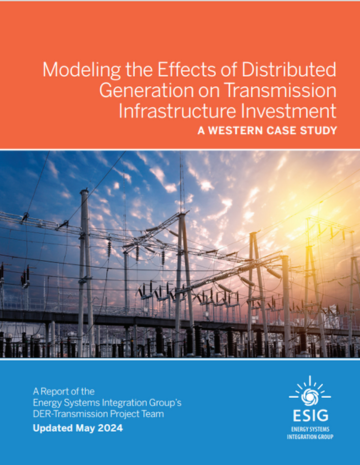[Note that the final version of this report is this May 2024 updated version. If you previously downloaded the earlier version, please replace it with this one. The executive summary remains the same.]
The increasing adoption of distributed generation technologies has the potential to transform the way we plan and operate energy systems. While we have some understanding of the relationship between distributed generation and the distribution system, the impact of distributed generation on high-voltage bulk transmission systems that connect major cities, planning areas, and states has received limited attention.
 This study focused on the Western Interconnection to explore how increasing distributed generation deployments (namely, distributed solar PV generation often paired with storage) may impact zonal transmission flows and the need for transmission investment. It also investigated potential synergies between transmission and resource expansion under distributed- and utility-scale-generation–dominant futures. Its objective was to provide insights into implications of distributed generation for transmission use and planning to help grid planners ensure a more efficient and reliable grid.
This study focused on the Western Interconnection to explore how increasing distributed generation deployments (namely, distributed solar PV generation often paired with storage) may impact zonal transmission flows and the need for transmission investment. It also investigated potential synergies between transmission and resource expansion under distributed- and utility-scale-generation–dominant futures. Its objective was to provide insights into implications of distributed generation for transmission use and planning to help grid planners ensure a more efficient and reliable grid.
Study Scenarios
The study modeled long-term capacity expansion over a horizon from 2031 to 2040 to evaluate planning decisions and short-term dispatch functionalities to analyze dispatch and flows for three scenarios:
- A centralized scenario holding distributed generation at current projections and meeting long-term needs through a variety of types of utility-scale generation
- A hybrid scenario assuming distributed generation growth at double current projections and meeting long-term needs through a variety of types of utility-scale generation
- A distributed scenario in which distributed generation resources were simulated as the primary method of meeting long-term planning objectives
Study Findings
- Distributed generation can significantly impact inter-zonal transmission flows.
- At moderate levels, distributed generation and distributed storage adoption could cause certain inter-zonal transmission investments to be delayed or avoided.
- The status-quo (centralized) and accelerated (hybrid) distributed generation adoption scenarios shared many common inter-zonal transmission investments.
- High levels of distributed generation could increase the need for inter-zonal transmission investment and storage investment.
Study Takeaways
The study findings highlight the complex trade-offs between investments in distributed generation, storage, and bulk transmission. The findings make clear that while moderate levels of distributed generation could help to reduce bulk-scale transmission investment, the need for such investment is not eliminated or significantly reduced. The results suggest the potential benefits of simultaneously planning for transmission, distributed generation resources, and utility-scale resources in order to optimize power planning outcomes, but the trade-offs illustrated in the study indicate that there is no single solution in the pursuit of achieving long-term system needs and clean energy policy goals.
Roll-out Webinar
DER Transmission Study Overview and Findings



